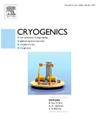Electro-magnetic-mechanical characteristics of 3D HTS INS and NI racetrack coils in complex physical fields
IF 1.8
3区 工程技术
Q3 PHYSICS, APPLIED
引用次数: 0
Abstract
To investigate the impact of insulation structure on the electromagnetic and mechanical properties of high-temperature superconducting (HTS) coils, numerical simulations are employed. A comparative study is conducted on the electrical, magnetic, and force distribution characteristics of three-dimensional (3D) racetrack insulating (INS) HTS coils versus non-insulating (NI) HTS coils under identical operating conditions and dimensions. To balance computational complexity and time, a 3D racetrack-type homogenization equivalent model is developed. INS HTS coil has no inter-turn resistance so that the current dimension is reduced by one level. A homogeneous T-A formula is used to establish anisotropic equivalent model, which enables addressing the 3D computational challenges of high aspect ratio superconductors. NI HTS coil is solved by H-method due to the presence of radial resistance. In this pure FEM model, which is not coupled with the circuit model, the real geometry in arc segment of the NI HTS coil can be equated to a concentric circle structure by using the rotational anisotropic resistivity method. It can be achieved by setting the resistivity matrix ρcoil. Meanwhile, to explore the weakening effect of the strain inside superconducting coil on superconducting performance under multi-physical fields, the application scope of the strain dependence formula of Ic under one-dimensional (1D) mechanical loading (Ekin’s power-law formula combined with Weibull distribution function) is extended from 1D loading to 3D complex stress state. And its accuracy is verified. Then the extended formula is applied to two 3D coils. The influence of mechanical loading on the critical performance of the coil under multi-physical field conditions is compared and investigated.
复杂物理场中三维高温超导INS和NI赛道线圈的电磁力学特性
为了研究绝缘结构对高温超导线圈电磁性能和力学性能的影响,采用数值模拟方法。在相同的工作条件和尺寸下,对三维(3D)赛道绝缘(INS)高温超导线圈与非绝缘(NI)高温超导线圈的电、磁和力分布特性进行了比较研究。为了平衡计算复杂度和计算时间,建立了三维赛马场型均匀化等效模型。INS高温超导线圈没有匝间电阻,因此电流尺寸减小了一级。采用齐次T-A公式建立各向异性等效模型,解决了高纵横比超导体的三维计算难题。NI高温超导线圈由于存在径向电阻,采用h法求解。在不耦合电路模型的纯有限元模型中,利用旋转各向异性电阻率法可将NI高温超导线圈弧段的实际几何结构等效为同心圆结构。通过设定电阻率矩阵ρcoil即可实现。同时,为了探究超导线圈内部应变在多物理场作用下对超导性能的减弱作用,将一维(1D)机械载荷下Ic的应变依赖公式(Ekin幂律公式结合Weibull分布函数)的适用范围从一维载荷扩展到三维复杂应力状态。并对其准确性进行了验证。然后将推广公式应用于两个三维线圈。比较研究了多物理场条件下机械载荷对线圈临界性能的影响。
本文章由计算机程序翻译,如有差异,请以英文原文为准。
求助全文
约1分钟内获得全文
求助全文
来源期刊

Cryogenics
物理-热力学
CiteScore
3.80
自引率
9.50%
发文量
0
审稿时长
2.1 months
期刊介绍:
Cryogenics is the world''s leading journal focusing on all aspects of cryoengineering and cryogenics. Papers published in Cryogenics cover a wide variety of subjects in low temperature engineering and research. Among the areas covered are:
- Applications of superconductivity: magnets, electronics, devices
- Superconductors and their properties
- Properties of materials: metals, alloys, composites, polymers, insulations
- New applications of cryogenic technology to processes, devices, machinery
- Refrigeration and liquefaction technology
- Thermodynamics
- Fluid properties and fluid mechanics
- Heat transfer
- Thermometry and measurement science
- Cryogenics in medicine
- Cryoelectronics
 求助内容:
求助内容: 应助结果提醒方式:
应助结果提醒方式:


